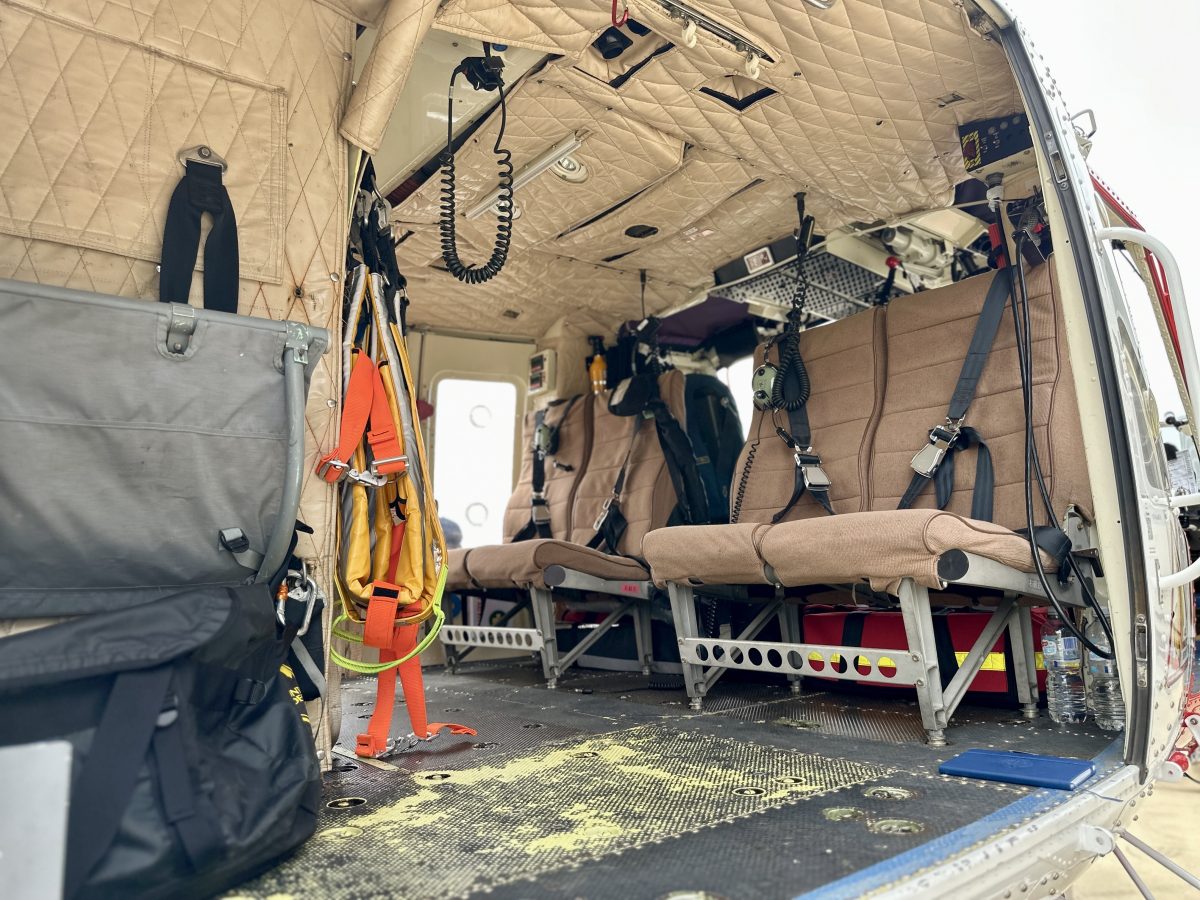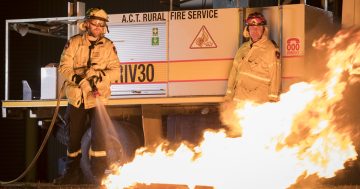
Steve Lever, pilot for the Kestrel ‘HeliTac 101’, a waterbombing aircraft. Photo: James Coleman.
Steve Lever has been flying helicopters for about 25 years, in Canada, the US, and even the Middle East.
“I’ve always wanted to fly since I was a kid, and when I learned that helicopters can go backwards and sideways, and the freedom of it, I was like, ‘Yeah, that’s what I want to do’,” Mr Lever says.
His latest assignment lands him in Canberra for three months.
Steve is a pilot for the HeliTac 101, one of three helicopters brought in to support the ACT Rural Fire Service (ACTRFS) during the 2024/25 bushfire season.
Contracted from Victoria-based companies Microflite and Kestrel – who also supply pilots, engineers and ground crew – the helicopters will be based at the Emergency Services Agency (ESA) helibase in Hume until March 2025.
ACTRFS chief officer Rohan Scott says the HeliTac, with its 1500-litre belly tank, will provide waterbombing capabilities and can carry a team of six firefighters to “hit some of those really remote fires and lightning strikes”.
The other, a Firebird 100, is a ‘Specialised Intelligence Gathering (SIG)’ helicopter that can provide infrared real-time video streaming and geospatial data collection. This is useful for “determining hotspots, looking for ignitions, and giving intelligence back to firefighters on the ground.”
“Firebird 100 gave us really good intelligence at the start of the Orroral Valley fire,” Rohan says.

The helicopters will be based at the Emergency Services Agency helibase in Hume. Photo: James Coleman.
“We’ve also used it for storm and flood responses to get that real-time data on impacts that may have occurred. And we’ve also used Firebird 100 to assist the AFP with missing person searches as well.”
It can also be used in suburban areas if needed.
“On elevated fire days, we will launch the aircraft regardless of the size of the fire as a pre-emptive measure,” Rohan adds.
A second HeliTac is expected in January, during the period of “heightened risk”.
“We’ve had some really good rain in the last couple of weeks, and that is leading to significant grass growth that will start to cure over that January or February period as we get the hotter weather.”

At the helm of the HeliTac 101. Photo: James Coleman.
The ESA also has an air tanker base at Canberra Airport in its firefighting arsenal. This base allows large tanker aircraft to fill up with fire-retardant foam. The State Airdesk and National Aerial Firefighting Centre also provide access to more than 100 aircraft across Australia.
“That collaboration between not only the ACT and NSW, but other fire services through a group, gives us really good capability,” Rohan says.
“Aviation assets are key for not only fire suppression, but also fire detection.”
The ESA is also investigating how drones could be used “not only for bushfires but also for structure fires, missing-person searches and everything else we do”.
“For example, a commander out in the field may be able to use a drone to get really good situation awareness for a part of the fire they’re managing.”
ACT Minister for Police, Fire and Emergency Services Dr Marisa Paterson confirms the government has no plans to purchase helicopters of their own given the existing lease program “works pretty well”.
“These helicopters will service the border region of NSW and ACT, and at this point in time, that is a service that works pretty well,” she says.
The ESA has the option to extend the loan of the helicopters if risky conditions persist past the usual end of the bushfire season in March.
Steve says the HeliTac, with a cruising speed of 130 knots (240 km/h) can be at the scene of a fire “quite fast”, and either open one or all four of the doors to its 1500-litre water tank once there.
“If we want to just pound [the fire], we’ll open all the doors, or if it’s like a grass fire and we want to spread the water out, we can just open one door.”

Inside the HeliTac 101. Photo: James Coleman.
Filling up can also be a challenge.
“The water snorkel only comes down to about 15 to 20 feet (4.5 to 6 metres), so we have to get the machine right down low, and in a lot of places, the water’s quite dirty so it can circle up and get on the windscreen and you lose your visibility,” he says.
For now, when he’s not running test flights between the helicopter base in Hume and the Googong Reservoir – “just checking all the systems and stuff” – Steve is getting to know Canberra’s food scene.
“I’ve had eight years of firefighting in NSW and Victoria, and working with floods as well, but this is my first time in Canberra,” he says.
“Been here for four days, so I’m just getting to know all the places to eat.”

















